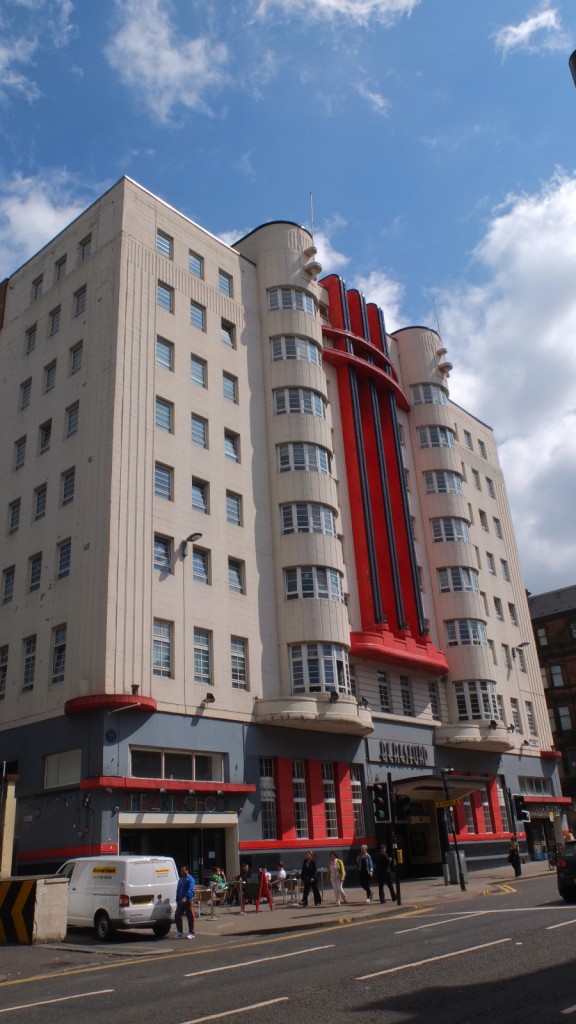After a day or two in Edinburgh we decided to take the train to visit it’s sister town – Glasgow. Two very different propositions, really. It’s a bit like the difference between Brussels and Antwerp. Glasgow is more of a creative hub, with a rich nightlife tradition – dance- and concert halls, cinema’s and the like. Edinburgh has more grandeur, almost capital-like. Being there, we visited the National Piping Center, which came as a bit of a shock and the Mackintosh house, which came more as a revelation. And of course we strolled a fair bit. Along streets bordered with ‘red stones’ – Victorian style grand houses sporting splendid red natural stone facades, typical British belle-étage basements, Dorian or otherwise styled pillars supporting the entrance and a gem of a garden in the back.
Moving along, we passed the xxx boulevard with the famous ABC/0² venue, causing all my inner alarm clocks going off. This finally could be it. One of those really rare historical venues, having been in a distant past a courteous ballroom and after that more likely evolving into a cinema or even a boxing ring. Somewhere I read that in Great Britain, they still keep a few of those pearls of popular culture, without the necessity of being an opera house, intact.
Well, in the end, my intuition wasn’t completely right. The moment we crossed the threshold, thrilled with expectation – the entrance looked promising – a security guy laid hands on us and called us back. “This is a venue sir! In a while the concert will start. Nobody is allowed during the set-up.” After recovering from our first fright, the utterly surprising thing was the kind of conversation unravelling between us and this agent-type. After I told him about my passion for old dance halls, to my no little surprise, he actually started rather enthusiastically citing all the phases of the venue’s development. Built in 1892 as a indoor zoo, in the ’20ies a kind of skating ring and a cinema after that. Since the ’80ies famous as a concert venue exploited by O². Now, I don’t want to underestimate security agents in general, or even being rude to the profession as a whole, but I feel very confident that in Belgium, or even virtually everywhere on the globe, one would rather not have such an entertaining conversation about the socio-cultural past of the building one happened to have entered without permission and being caught consequently. This really blowed our minds. I mean, the guy was so perfectly friendly and erudite. For the rest: the normal amount of gorilla style muscles, short-cut hair and al the necessary tools girded around the waist to perfectly demolish any intruder. In a bizarre way U.K. culture is most of the time about keeping up appearances.
Bearing this experience in mind, we decided to visit the brand new Riverside Museum. A typical example of ‘landmark architecture’ albeit that the pathetic was kept well in balance with it’s function as a museum. And that, one might think, certainly is some of an achievement. The building is even so unspectacular, that, biking by some weeks earlier on our way to Loch Lomond, I first considered it as a kind of specialized supermarket, without much of a clientele, because of the gigantic empty parking lot in front. Observing more closely, the construction is more or less following the logic of the Danmark model (Head – Neck – Body partitions) encapsulated by an impressive acclimatization layer but nonetheless reveling a gigantic museum space inside.
And we dearly love those Brittisch Museums! To begin with, they are for free. But even then: what an intelligent constructs they are, full with interactivity. Whether your 6 or 96 one can go there and have a good time. There literaly is something for everybody: for every age and every learning style. I suppose they are not coming cheap, but for this kind of an investment, any museum should be perfectly OK for the next decade. Temporarily exhibitions? Never heard of! Neatly designed collection or exhibition profiles? Forget about it! Every thing next to the other and a lot of everything. Not 1 steam lock, but a dozen, not one old timer car, but 300, etc. In the end everything starts with a fantastic story: authenticity, multimedia, erudition, fun, etc.
For several reasons I was really impressed by the double-deck tram, used as a starting point to explain dance culture. There is a screen showing movies with dancing people, interviews with eye witnesses and of course some fantastic princess – style dancing robes from the ’40ies, ’50ies and ’60ies. Marvelous and yet so near to my heart. From my own Dansant research project in Antwerp (hence the name of this blog), I learned how important trams used to be for the youthes of the ’30ies, ’40ies and ’50ies. This was their dream vehicle to go out. Dress codes used to be so strict, that going out was only allowed when one dressed up properly: suit and tie or evening dress and perfect healed shoes. So biking to a dancing hall was an impossibility and cars or taxis far to expensive. So one took the tram. Having the explicit advantage for the parents, their kids had to be in on time. Last tramway, you know?

